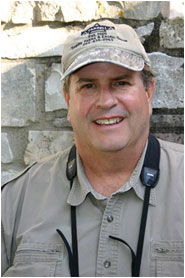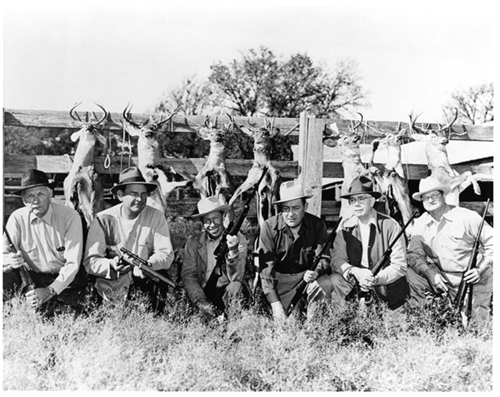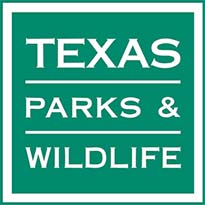History of the Farrell Ranch
Ranch History
Hunting In Texas For Over 90 Years!
 My name is Pat Farrell and I am the third generation of my family to live and work here on the Farrell Ranch. For over 90 years, the Farrell Ranch has been conducting hunts for Texas whitetail deer. In fact, the Farrell Ranch is considered by many to be one of the oldest, continuously operated high-fenced whitetail deer hunting ranches in Texas.
My name is Pat Farrell and I am the third generation of my family to live and work here on the Farrell Ranch. For over 90 years, the Farrell Ranch has been conducting hunts for Texas whitetail deer. In fact, the Farrell Ranch is considered by many to be one of the oldest, continuously operated high-fenced whitetail deer hunting ranches in Texas.
Soon after purchasing the land in 1926, my Grandfather, Baylis Earle Farrell Sr., constructed a 9’ high deer fence that completely surrounded the hunting property and initially stocked the Ranch with 86 Texas whitetail deer purchased from around the state.
At that time in Central Texas, there were very limited numbers of Texas whitetail deer. Game laws were few or non-existent and the locals often lived “off the land” and harvested Texas whitetail deer at will for sport or for food to feed their families. As a consequence, the 9’ high deer fence was constructed not only to keep the stocked Texas whitetail deer on the property, but also to keep the local hunters off the property to allow a hunt-able number of Texas whitetail Deer to once again become established on the Ranch.
By 1934, the Texas whitetail deer population on the Ranch had increased to a point where my Grandfather felt he had enough deer to conduct deer hunts and established a Texas Whitetail Deer Hunting Club, which consisted of about 12 individuals from Dallas, Ft. Worth and Houston. These men continued to hunt Texas Whitetail Deer on the property until the late 1950’s when my Grandfather entered into an exclusive lease for the whitetail deer hunting with one of the original hunting club members.
In the late 1960’s, Texas exotic game consisting of Axis deer, Black Buck, Fallow Deer, and Red Stag were introduced to the property and hunts for these animals soon began. The exclusive hunting lease executed in the late 1950’s by my Grandfather was continued thru the years until 2002 when it became apparent that our family’s goals for the hunting operation and for the game animals on the Ranch would never be achieved if a “lease type “ deer hunting operation was continued. Thus, the existing deer lease was terminated and the management of the Ranch’s Texas whitetail deer and exotic hunting operations placed, once again, under direct family control.
Since that time, an intense Texas whitetail deer and exotic game management scheme has been established on the Ranch utilizing “package” type hunts only whereby both the quantity and quality of the animals taken can be more closely controlled than is usually the case in the typical “lease” or “hunting club” type of hunting operation.
Many stories have been told and written about the Farrell Ranch over the years but none gives a better flavor for what it was really like to be on a deer hunt at the Farrell Ranch during my Grandfather’s time back in the early 1950’s than the following article which first appeared in the November 1952 “Texan Preview “ magazine. Enjoy a trip back in time!
“HOW TO RUN A TEXAS DEER HUNTING CAMP”

The hunters shown above with their deer did not have to trek halfway across Texas for their sport. Three are from Dallas and they went barely a hundred miles to get to Earle Farrell’s Texas whitetail deer hunting paradise near Meridian. Mr. Farrell is pictured on the right.
A few miles north of Meridian, Texas on Highway 6 is a big gate marked with a triangle centered with the name “FARRELL”. To the neighbors, it indicates the entrance to the 5,000 acre Ranch belonging to Baylis Earle Farrell Sr. To the twelve men from Ft. Worth, Dallas and Houston who have banded together into a Texas Whitetail Deer Hunting Club, it is the entrance to a sportsman’s paradise.
The Ranch is run strictly for the enjoyment of the Texas whitetail hunt club members and their guests. They gather there during the shooting season to try their luck at Texas whitetail deer, dove, and quail, and in the off-seasons for house parties at the headquarters house, which is now actually a hunting lodge.
According to the Texas whitetail deer hunt club rules, each member can kill two whitetail bucks each season and can have two guests who are permitted to kill their limits as well. Mr. Farrell’s Texas deer herd is a private one, estimated now to be well over 2,000 head- up substantially from the 86 deer he purchased and stocked on the Ranch in 1926, but he enforces the Texas state deer hunting regulations because he feels that the game laws protect his investment. As over half of the deer on the Farrell Ranch are usually bucks, and as only 50 or 60 are killed each year, there is always ample game.
The first week of the season is reserved for the Texas deer hunt club member’s only- no guests are allowed. They come for the big opening day dinner, which is always held on November 15, and stay over for as many days as business will permit.
Incidentally, the opening day dinner is really something. There is everything from baked turkey, brisket, and ribs with all of the trimmings to plum pudding, fruitcake and salted nuts. All is “on the house”. After that, the Texas deer hunting club members furnish their own food, each bringing a list of groceries as assigned to them by the president of the deer hunt club, who makes out the menus for each meal of that gala week a good two months in advance.
The hunting club members have built a hunting cabin nearby. Inside are five bunks and outside is a sign reading “ WHERE THE WEST BEGINS”. A large cowbell hangs inside the cabin. It is attached to a wire to Mr. Farrell’s bedroom in the headquarters house. Come time to get the hunters out of bed, Mr. Farrell pulls the wire and the cowbell rings.

The Texas whitetail deer hunting club’s cabin on the Farrell Ranch
The headquarters house is the main center of activity and interest for everyone. The house is at the base of one of the mountain-sized hills, which rise west of Meridian, and faces a high, fertile valley overlooking the surrounding countryside. On a clear day you can stand on the screened porch and see the calm beauty of the meadow sloping to a rocky creek, the varied greens of pecans, elms, oaks and cedars, which cover the rugged backdrop, and the never ending panorama of the rolling plains which stretch to the left.
On a day when the elements are restless you can watch the wind sweep through the draw, the dark clouds envelope the sharp silhouette of the mountains, the forked lightening lashing at the unprotected redbud and yaupon, and wonder if there is any truth to Mr. Farrell’s statement that the house, being located in a valley, is out of the path of the many tornadoes which pass it due to the position of the mountains surrounding the house.
The white, clapboard headquarters house was built in 1886 and designed in the typical Texas “T” shape. It is now wired for electricity and piped for gas, which permits all of the modern comforts along with its picturesque-ness, a source of entertainment as well.

The Headquarters House on the Farrell Ranch- built in 188
The living room contains many relics of the Allison Nelson and John Baylis Earle families of which Mr. Farrell is a member. The chandelier is an oxen yoke, which his Grandfather Earle used on one of his wagons when he hauled cotton to Mexico from Waco, Texas during the Civil War. The round trip took 580 days but it was worth it, because at Vera Cruz the cotton was traded to England for the machinery greatly needed in the blockaded Confederacy. Adorning the walls are all sorts of hats- Mexican sombrero, 10 –gallon Stetsons, battered cowboy felts, coonskin-and a selection of guns, including an old cap and ball rifle which belonged to Mr. Farrell’s Grandfather, a Civil War Musket, and a Swiss army rifle, deer heads from the Ranch, and an assortment of rattlesnake skins from snakes captured during the many rattlesnake hunts conducted each year on the premises. Memorabilia includes a fine collection of Indian arrowheads, spearheads and a Spanish cannonball, found on the place, a citation to Allison Nelson from the Confederacy, bottles and pottery. And there is the rock fireplace where Mr. Farrell, whose hobby is cooking, does some of his famous barbecuing and broiling. Mr. Farrell points out some of the memorabilia found inside the living room of his Ranch’s headquarters house.
Mr. Farrell purchased the property in 1926 because it adjoined some land his Great-Grandfather Allison Nelson had owned. At first he went in for raising Hereford cattle, sheep, goats and horses but in 1934 he discovered that it was just as profitable, and a lot more fun, to exploit the shooting privileges for the Texas whitetail deer he had stocked earlier on the Ranch and promptly settled down to do just that. Nowadays, he still pastures blue-blooded Hereford cattle- but makes sure the cattle do not interfere with the whitetail deer and other wild game.
Perhaps the real charm of the Farrell Ranch is that Mr. Farrell did not try and make it over when he turned the property into a Texas hunting Ranch. As in old times, a day there begins mighty early. While it is still dark, the house is a-buzz with men dividing their attention between enormous breakfasts and getting together their hunting equipment. By daybreak, each has settled down inside one of the brush blinds only to emerge for lunch and a short siesta before going out again until dark. Following dinner, everyone sits around playing games or listening to the stories Mr. Farrell has to tell about the Ranch.
There are numerous legends. Dan Pike, famous Indian fighter, lived in the house at one time. Allison Nelson, who was the first mayor of Atlanta, Georgia, came to Texas as a major in the Mexican-American War (he was one of those who stormed Chapultepec) and stayed on to settle with his family in Bosque county in 1854. Once, he and 200 other citizens of the community organized a ranger force to go after some Comanches who had stolen their horses. The trail left by the Indians forked at Fort Graham near the present city of Glen Rose, showing that some of the culprits had gone inside of the fort for protection while others had continued on to the plains. The commandant of the fort, being a federal officer, refused to allow the citizens to get at the thieves. Allison Nelson gave him an “or else” ultimatum. The result was that the horses were returned to the citizens but the army moved the Indians to the Oklahoma Territory overnight. The fort was soon abandoned. In 1859, the Indian raids became so frequent that Nelson was forced to move his family to Waco.
By far the most exciting tale is that of buried treasure. The Ranch is on the old Comanche Trail. The Spaniards undertook to guard the trail to apprehend raiding parties of Indians, which explains the many arrowheads and the cannon ball found on the Ranch. One time, as the story goes, the Spaniards were taking 12 jack loads of gold over the trail when the Indians attacked. Finding themselves out-numbered, the Spaniards scrambled up the mountain back of where the house now stands and buried the treasure in one of the many caves scattered along the top edge of the mountain. The Indians overpowered the Spaniards, with only two or three able to escape back to Mexico to tell their story. People have been searching the caves and digging for the gold ever since.
Despite the pockmarked condition of the mountain, Mr. Farrell says that he has never heard of a bit of that loot being found. He thinks that if the rattlesnake population wasn’t so thick up there, treasure hunting might be a little more intriguing.
While at present, those visiting the Farrell Ranch must confine themselves to hunting Texas whitetail deer and birds, Mr. Farrell has started stocking the place with wild turkey and fish, and is considering adding elk and buffalo, which he had at one time stocked on the Ranch but had to liquidate because the bulls became so ferocious.
But whether or not these things are done, the men who come from Ft. Worth, Dallas and Houston won’t care, for once inside the gate of the 9-foot deer-fence, which encloses the Ranch, they can discard completely the worries of the atomic-ridden world for the unlimited pleasures of a changeless outdoors world.
Contact
Pat Farrell
11645 HWY. 6
Meridian, TX. 76665
Cell: 254.315.0303
Email Us
Click here for directions
Ranch Hunting Season
October through March
May through June (Axis)

